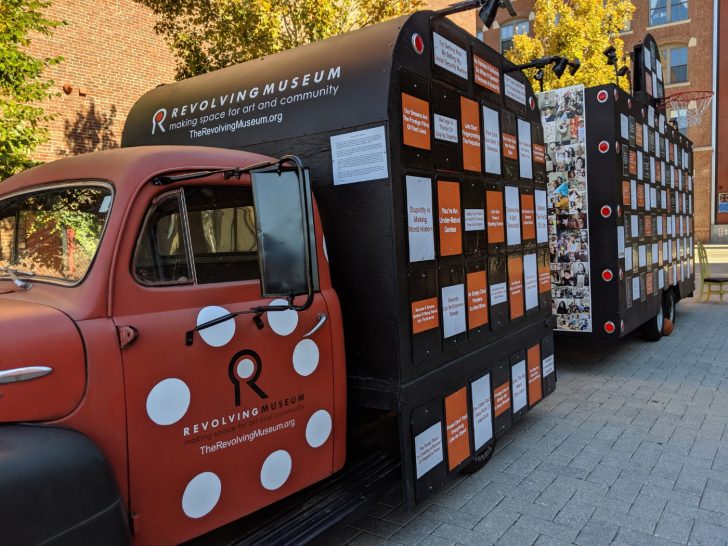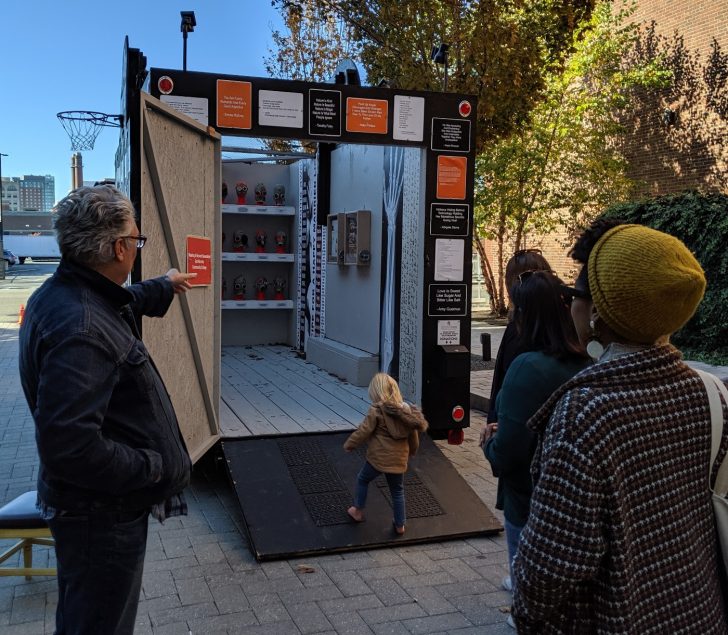“This is the thing, I’m more interested in the experience that happens than the actual artwork itself. I love the art, but I think art is the catalyst. In a museum, there is the experience of one-on-one with the object but when you have an environment, in the middle of the night, in the weather, and the camaraderie with artists all together, and food, and music, and activities like a three-ring circus, it’s a whole different thing. And those are the things that I want.” – Jerry Beck, 2019
You might have been attracted to Jerry Beck and his non-profit cultural organization the Revolving Museum by one of the many strategic lures set up to summon the interaction of passersby in municipal locations. In Boston’s Downtown Crossing, a basketball hoop bolted to the side of a truck elicits an unusual exercise—the idea of playing a quick game of pick-up in a space usually reserved for tourists and wealthy shoppers makes walking to the T after a shift in the hotel kitchen special, like you live here too. Beck tells me this project, the Poetry Mobile, was born from an idea first proposed by his students who he had met and worked with in various high school art programs. Their work comprises the bulk of the exterior of the exhibit: an red, black and white antique 1952 Ford pickup retrofitted with a trailer, both covered in poems of different lengths and authors. The effect is some sort of Halloween flavored U-Haul, at once confusing and bemusing. What is its purpose? Why is it here?

Much of the Poetry Mobile is a loose, swirling plan to promote writers, performers, designers, and builders, with Beck as a center of gravity for the whole revolving galaxy. A workshop trailer abutting the truck inspires people to write a poem on a magnet, which they can then showcase. Inside the vehicle, under netting reserved for stray basketballs, red mannequin heads wearing gas masks sit on a series of shelves in an uncomfortable arrangement, each with its own plaque quoting what it might say if it could speak. Nearby some young clothing designers working with recycled materials present a rack of their work: denim jackets decorated with large, frayed patches and Maya Angelou poems, a drawstring backpack fashioned from overall straps and featuring a mural of black and brown bodies, a vest with friendship bracelet tassels hanging from the neckline. Deciphering how all these seemingly disparate elements are to interact with each other to form something cohesive is troubling to anyone trying to narrativize space—but I’ll try.
Beck came onto the art scene in the mid 1980s when he was twenty-three years old, right before friction arose in his graduate museum-values driven education and he dropped out of The School of the Museum of Fine Arts in Boston. He found a foothold in ’80s punk culture and the theory-free brand of non-specific anarchism that inhabited the moment, finding camaraderie with others who felt similarly alienated. In 1984, Beck procured his first conceptual work titled “The Little Train That Could…Show,” in which twelve abandoned train cars (stationed not far from where the Institute of Contemporary Art now stands) were re-outfitted to house the works of collaborating artists. Members of homeless communities sleeping in the cars at night allowed the artists to use their spaces, with some even participating in the festivities after the exhibit premiered. The Revolving Museum banner was established, and its exhibitions and installations have been well-received ever since.
I visited Beck in Fitchburg during the summer, the town he has operated in and out of, proudly embodying the Massachusetts spirit of being neck-deep in history and debt while stuck somewhere between its desire for new development and resistance to the change developers want. Some areas of downtown feature the remnants of closed shops and unsuitably converted historic buildings. Other areas host businesses so niche they in no way could sustain a regular income, notably the sister storefronts of “Gerry Martel’s Classic Carriages” and “Gerry Martel Collector Cars”. I wondered if Jerry knew Gerry when Jerry, who did not know what I looked like, recognized me from a hundred feet away as the only citizen gawking at the twin stores. Calling to tell me to meet up the road where he had parked the Poetry Mobile, Beck wore a flamingo-pink button-up, showing a little chest hair, and his jeans were purposefully tucked behind his Adidas’ tongues. I was thoroughly impressed by his commitment to appearing dad-casual, as if he wasn’t standing next to this truck covered in poetic ornaments and filled with provocative articles.
Inside the trailer, we sat and talked for as long as both of us could muster. He began asking me questions about myself and my interests, interviewing me before I had the chance to interview him. His earnestness to know me skirted my flimsy attempts at looping back around to him. I had this idea that Beck would be prepared to explain some of his artistic choices, but he tends towards viewing his work less as a series of deliberate productions and more as a growth of coincidences. Continuations of previous projects, the available skills of others who want to get involved, materials or spaces offered, all roll Katamari-like into new exhibitions for the Revolving Museum. The Poetry Mobile—with its traveling ecological multimedia performance-enhanced workshop, sculptural and fashion components, and vague focus on climate change—is a testament to Beck’s understanding of an artistic work’s inherent eclecticism and an affirmation of his desire to upset the traditional artist-art-viewer relationship.

The mannequin heads, for instance, are uniquely horrifying situated as they are in the exhibit, aside Mitch Hedberg one-liners and youth empowerment. Some of the gas masks are child-sized, reminding me of a display in a British war museum featuring equipment never used in service, but these seem to be. Their seriousness led me to believe that this was the exhibit’s main concentration, with the remaining attractions only intended to coax the public inside so they may look at this disturbing choir. When asked if this was the case, Jerry seemed unwilling to reveal their contextual significance. He did explain his plans for using them in an experimental theater piece where he will ask volunteers to wear the masks and read from dramatic compositions, which I imagine as a kind of apocalyptic Spoon River. What I initially thought to be a focal point was the wardrobe and script for a performance that has yet to happen. It is one of many processes the Revolving Museum can claim as its foundation.
When viewed as an organizing artist, Beck’s frenetic body of work goes down a little smoother as promotion for a larger philosophy. Viewing individual poems or Beck’s originals from the Poetry Mobile may distort your sense of scale and their purpose, each coming off pithier and less ideologically stable than the last. But viewed en masse, Beck’s work and collaborations contribute to a lifelong project to bring others to the idea that art is (or should be) a festival, where creative or aesthetically minded decision-making is the only qualifier one must possess to attend (and humans already do that). Beck’s way of being casually taken with everyone he meets in artistic spaces goes further than flattery or networking. For in those moments of introductory compliments, he is finding reason to convince a stranger of their existing artistic merit and then getting them to act purposefully on it. He carries this act into the classroom, intending to show students how to flex poetry muscles they already have by reintroducing them to the ways they text, post, dress, and read. Now his Poetry Mobile is covered in their work, surrounded by their performances and volunteerism. So he must be convincing them of something.
Concerned with audience initiation, Jerry Beck aims to awaken a sense of artistic spirit and community in his audience, spurring growth, gesturing for you to come on stage. I used to be in a 28-piece folk punk marching band with at least six guitars and three drummers, a whole horn section, two accordions, a spoons player and four harmonicas, in which everyone sang. The audiences who liked us met us where we were and how we were: sprawling, passionate, and loud. Beck’s work functions similarly, and those who like it enjoy it because they are not looking for answers to the mysteries of life at a festival. In a vacuum, Beck’s pieces seem uncontroversial statements against materialism, climate change, and loneliness in the modern age. But in Beck’s case it’s bad faith to look at his pieces without the rest of the Revolving Museum community he’s helped to create. If you like the spirit of community, you’ll enjoy the festival.
